The elaborate tomb of an ancient royal scribe has been unearthed in a discovery that will help illuminate the relationship between Egypt and its eastern neighbors, the antiquities chief said Wednesday.
The intricately decorated tomb belonging to Ken-Amun, who was in charge of overseeing the royal records during the 19th Dynasty (1315-1201 B.C.), was unearthed in the village of Tell el-Maskhuta, 75 miles (120 kilometers) east of Cairo, said Zahi Hawass, head of the Supreme Council of Antiquities.
Tell el-Maskhuta was a settlement in the Ismailia governorate containing a garrison that supplied and armed the ancient Egyptian army before the troops went on military campaigns east of the border.
Ken-Amun's tomb is that first Ramesside tomb to be discovered in Lower Egypt and is built from mud brick, consisting of a rectangular room with a stone-domed ceiling. Hawass said the inscriptions would aid in the understanding of Egypt's relationships with its neighbors to the east.
Inside the tomb, the walls are decorated with reliefs of funerary scenes, including Chapter 12 of the Book of Dead — an ancient text intended to help the deceased in the afterlife — and a scene of women mourning.
The wall's inscriptions tell that the scribe's wife was called Isis and worked as a musician for the God Atum. A large limestone pillar also was discovered depicting the God Set, the god of darkness and chaos, in front of the 19th Dynasty king of the time, whose name was not written. On the same pillar, the name of the capital of the Hyskos — an Asiatic people who invaded the eastern Nile Delta in the 12th Dynasty was found.
People continued to use the site as a cemetery, and 35 Roman-era graves were also discovered during the same excavation.
